Disclosure: Meeple Mountain received a free copy of this product in exchange for an honest, unbiased review. This review is not intended to be an endorsement.
When Pinocchio arrives in the city of Catchfools, he follows the advice of his new “friends”, Fox and Cat, and buries his five gold coins in the Field of Miracles. He then takes a walk, believing his gold will multiply and grow before he returns.
Pinocchio is one of my favorite books. Simultaneously, it is one of my least favorite movies because of Disney’s utter misunderstanding and subsequent distorting of the themes—despite the cute illustrations. Carlo Collodi must have rolled over several times in his grave. But I digress.

I know what you’re thinking. Gold doesn’t grow on trees. Pinocchio should have known better. You’re right. Even gold can’t grow more gold. And besides, what does that have to do with My Farm Shop? Pegasus Spiele’s title is finally hitting shelves and tables everywhere. Rüdiger Dorn (Luxor, Istanbul, Las Vegas) invites us all to get our hands dirty and run a homestead farm and shop to see if we can turn a few goods into gold. Let’s see what it’s all about.
Stoop down and dig with your hands a little hole
At the outset, each player receives a slightly oversized Farm board depicting ten fields which correspond to the numbers two through twelve on the dice (two and twelve share a space—how friendly!). Each field features an icon depicting its current use. Players also receive a Farmstand board that can hold sixteen resources along with one of each of the game’s four Resources—Honey, Yarn, Milk, and an Egg.
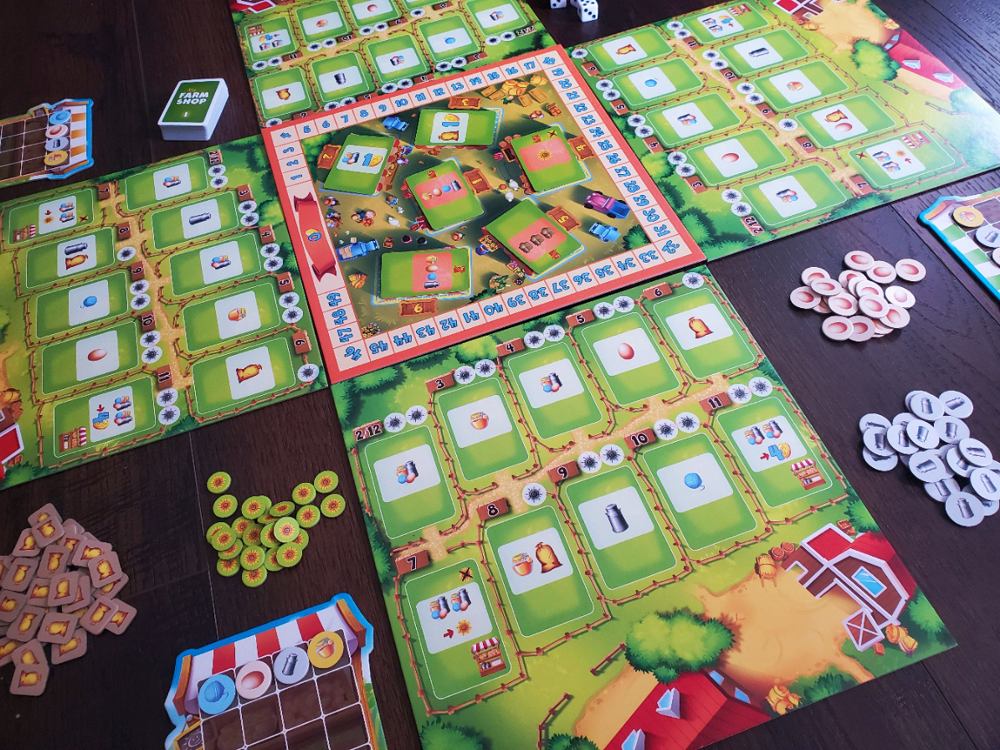
In the center is a Market Board. Around the outside is a money track that is used for player scoring. Inside are pictured six stalls into which the players will deal the Field cards throughout the game. The Field cards must be sorted and formed into a deck based on the number of players. I’ll have a lot to say about this deck later.
The game’s Resource tokens are spread around the board in piles along with piles of Burlap sacks and Sunflowers. My Farm Shop also comes with three separate expansion modules that slightly adjust this setup, but I’ll discuss those in a section below.
Player turns are fairly simple. One person rolls the three dice, and then chooses to use one die to purchase a corresponding Field card from the central Market. They must then place that Field over one of the ten spaces in their Farm, covering any previous feature. The Field then assumes this new use. The remaining two dice are then combined to be used by all players simultaneously, allowing them to reap the benefit of the matching Field in their own farm. Finally, the Market is replenished with the next Field card before play continues with the next player.
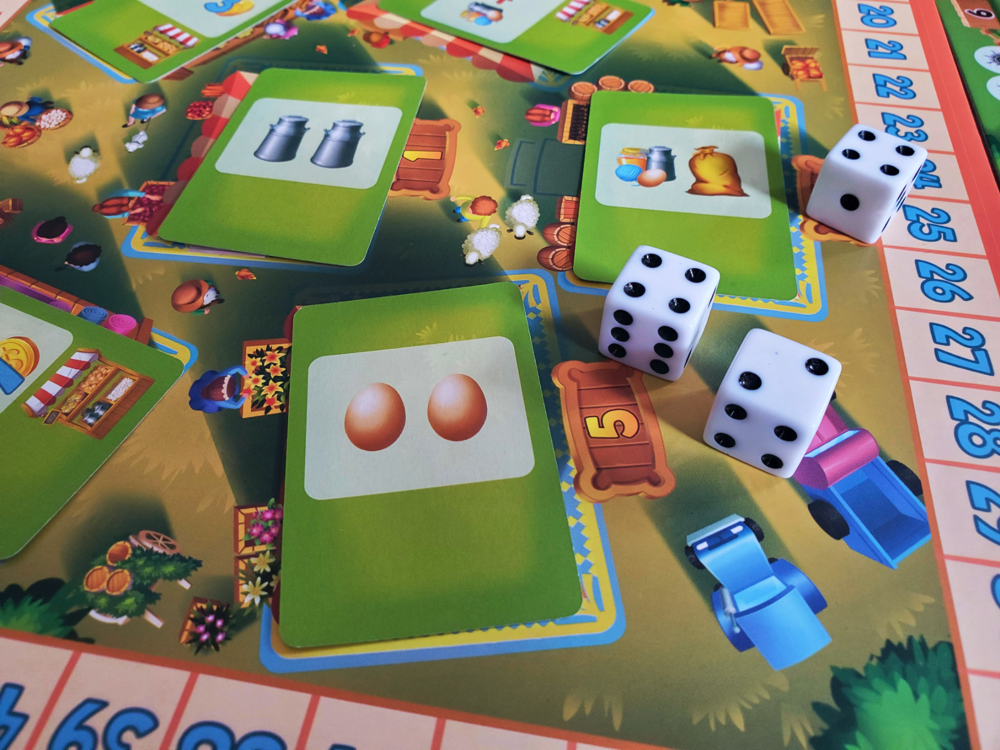
Throughout the game, the Fields will either produce one or more of the game’s Resources or allow players to discard Resources in exchange for Coins, Burlap sacks, and Sunflowers. The decision space of the game rests entirely in deciding how to continually evolve the farm with these new Fields in order to balance Field production and the relentless pursuit of profit.
Play continues in this fashion until there are no remaining Field cards to replenish the Market, at which point the game ends. With one final flourish, players are allowed to activate one Field of their choice as a final action. The player with the most money wins.
Along the way, there are a few tools that assist hopeful farmers. Burlap sacks, which can be acquired from one of the initial Farm fields as well as from several Field cards, are used to alter a rolled die by one each either in visiting the Market or when activating a Field. Sunflowers can be placed on a Field in order to boost that Field’s production by one, either netting an extra Resource or gaining a little extra cash.
Fetch a can of water, and water the ground
My Farm Shop grows up a bit right before players’ eyes through three expansion modules that give the game a hint of variety and strategy. The Jump-Start module adds a bit of variety to each player’s Farm board by assigning two random production Fields that can be placed in open spaces. Minimal impact, so an easy addition.
The Goals module introduces—you guessed it—goals that reward certain efforts for the first and second farmer who successfully complete the tasks. Six cards are included, two of which are dealt out at Setup. You don’t need the farmer’s almanac to know these just make sense.
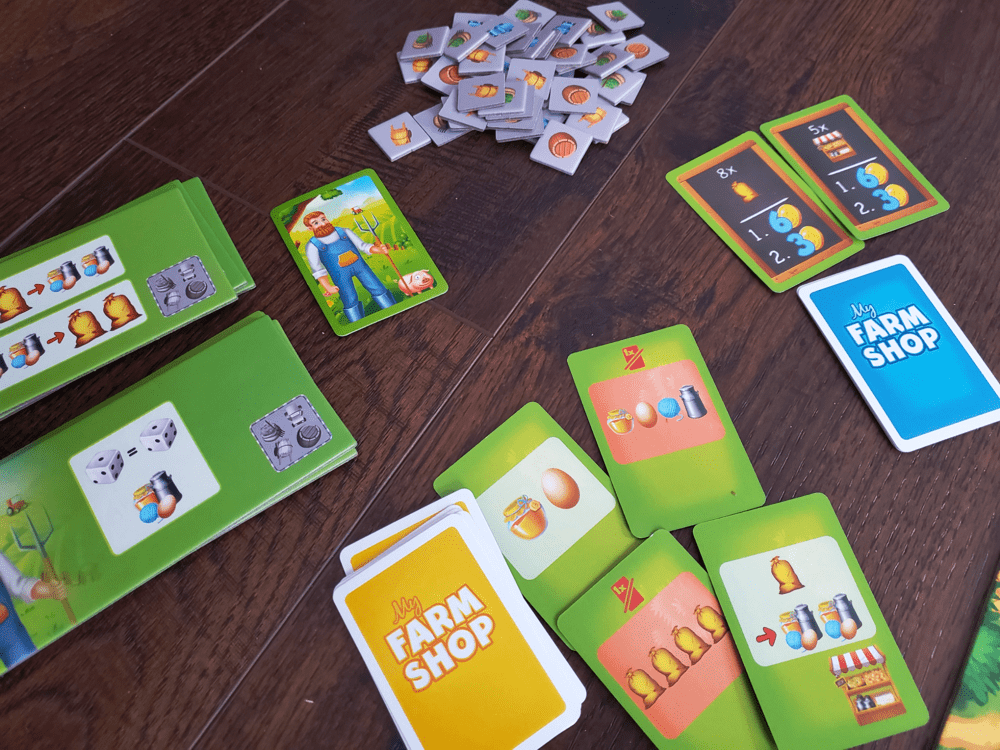
The Farmer module is a bit more interesting. During Setup, four special abilities are dealt out near the Market with a token being assigned to each. Also, one of the stalls in the Market is dealt the Farmer card instead of a Field. When a player chooses the Farmer card from the Market, instead of selecting a Field to improve their Farm, they collect two of the special ability tokens which can then be used during any future turn. The Farmer is then moved to another stall, discarding a Field card before replenishing for the next round. I would consider the Farmer essential at four players, and at three or two, why not?
You can return in about twenty minutes
Without the modules, the game is a breeze. First you set up a couple of solid Yarn-producing Fields with nary a sheep to be found. Then you add a lucrative Field that somehow organically turns Yarn into cash. As a side note: if you ever find a field that lets you toss yarn out on the ground, only to return the next day to find gold coins, you hold onto that field and you go get you some yarn!!
Once you begin to add the modules, My Farm Shop starts to feel more like the game it was intended to be. A little random variety in the setup, a couple big goals to race after, and some special abilities? I added them one at a time, and I honestly felt like I was getting to know the game in stages. When I finally played the full boat, it nearly felt right for the first time. When all the dust settles, there is substance in the box’s mechanics.
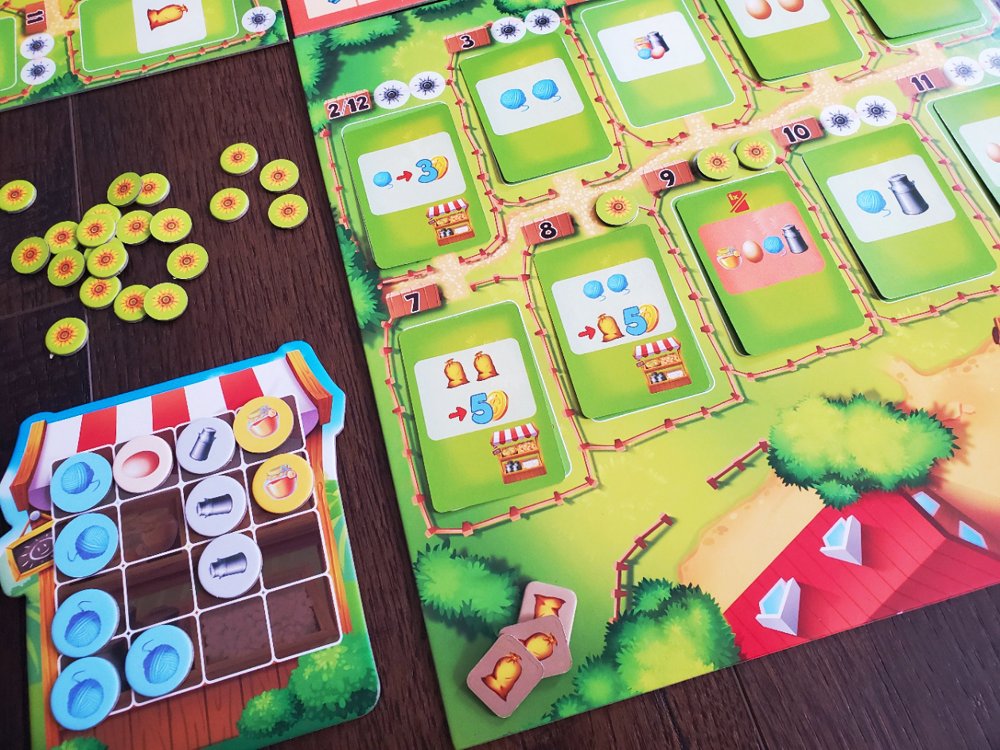
It becomes obvious, and quickly, that the Field deck is storyboarded. During Setup, the Field cards, which are marked with stage numbers, are organized in such a way that they will naturally guide the progression of options and decisions from Field production early toward Field monetization in the endgame. This is nowhere more obvious than stage 4, which includes nothing more than arrow cards that allow duplication of existing Fields—sometimes multiple Fields of choice, buffers for the transition. I can see how a completely randomized deck could facilitate nightmare scenarios with no viable escape. There is no other way.
The Sunflowers are a red herring. There, I said it. They couldn’t have less impact if the rules said to simply glue them to the board for decoration. They invite the squandering of resources for a payoff that can often be remembered and counted on one hand. It’s a shame, too, because in real life I rather like sunflowers. There’s something appealing about a flower I can look up to.
With regard to the artwork, My Farm Shop struggles with looking like a kids game. The illustrations remind me of Chai or ArchRavels—that airbrushed cartoon human look that invites children and confuses adults as to a game’s true audience. The mechanics allow far more depth than the surface suggests. It is a disconnect that could perhaps be overlooked, though it really can’t be denied.
I’ve had the most fun on the farm with two players. Even though the game features little down time anyway, there is almost none in a two-player outing. The Setup variety distinguishes the farms just enough to start on different feet. The Goals are a footrace with all the tension of staying close while trying to build the engine for victory. The Farmer module keeps large combos in play that seem to land with greater impact. Plus, the ability to effectively monitor both farms lends weight to every decision over the dice. Every added player stretches the mechanics just a little thinner and reveals the blemishes just under the skin.
And you will find a shrub quite loaded with money
If you can’t tell from the buckshot thoughts, I have mixed feelings about My Farm Shop. I want to like it more, but for some reason I don’t. It is rock solid. Mechanically, there are interesting decisions throughout, but something in the game prevents my heart from getting any real traction. The artwork doesn’t help, but I don’t think that’s it. I enjoy loads of games with childish aesthetics.
Maybe it’s the sense that the most I’ll accomplish is a singularly useful engine-ish pattern that is semi-dice-dependent and slightly unrealistic. Fields of… yarn? Fields of… honey? What kind of farm is this? There’s not a single bee on my Farm? Or a sheep? Or a cow? Or a chicken? But there are plenty of sunflowers that are really fish? And not a single magic wand to turn them all into cash! For all the animal byproducts in the game, you would think there’d be another animal on the box besides the Pegasus!
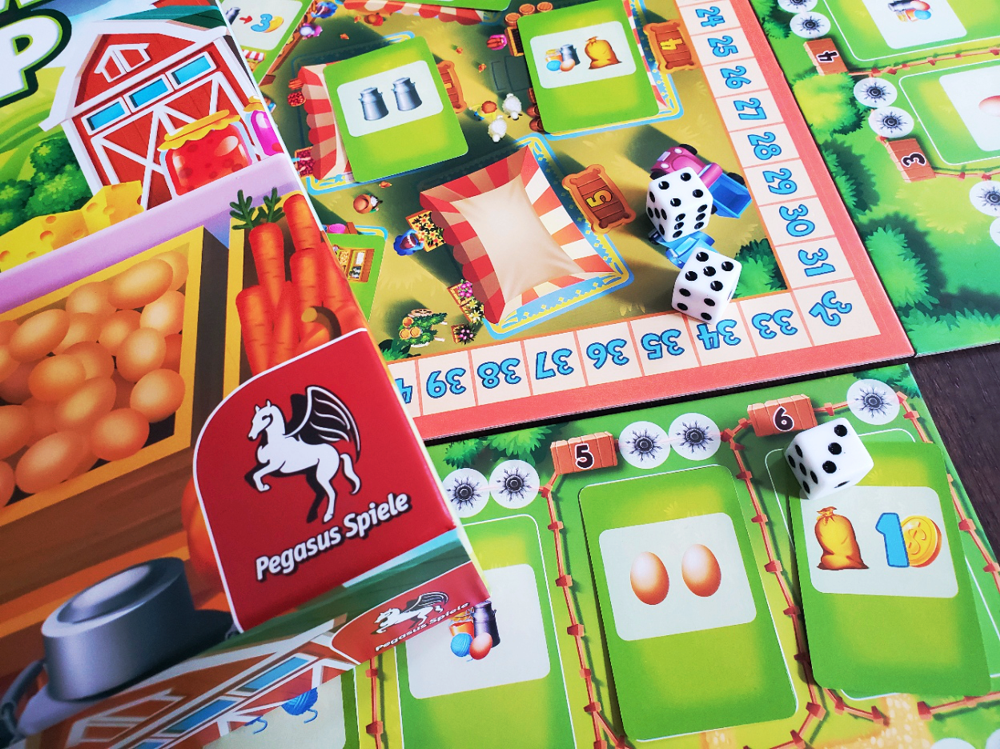
Ultimately, I think the biggest problem with My Farm Shop is that it’s not really a farm. It never feels like a farm. There’s no plowing. No planting. No tending. No nurturing. No customers. Just poof! Eggs from the earth that hatch golden coins. I’ve heard talk of something like that in one of my favorite children’s novels, except without the eggs.
Everyone who has joined me at the table for this one has confessed some inexplicable flaw—a decent experience, but nothing that begs another play. If I were to pinpoint my trouble, it’s that this simplest granddaddy of gaming themes requires an inordinate suspension of disbelief. There are too many gaps. There’s no sense to it all. Maybe I’m too picky when it comes to themes, but I cannot tell a lie.
* If you’re looking for an awkward, but far more accurate portrayal of Pinocchio, try this flawed gem from 2020, or join me in getting your hopes up for Guillermo Del Toro’s take which is due this December.


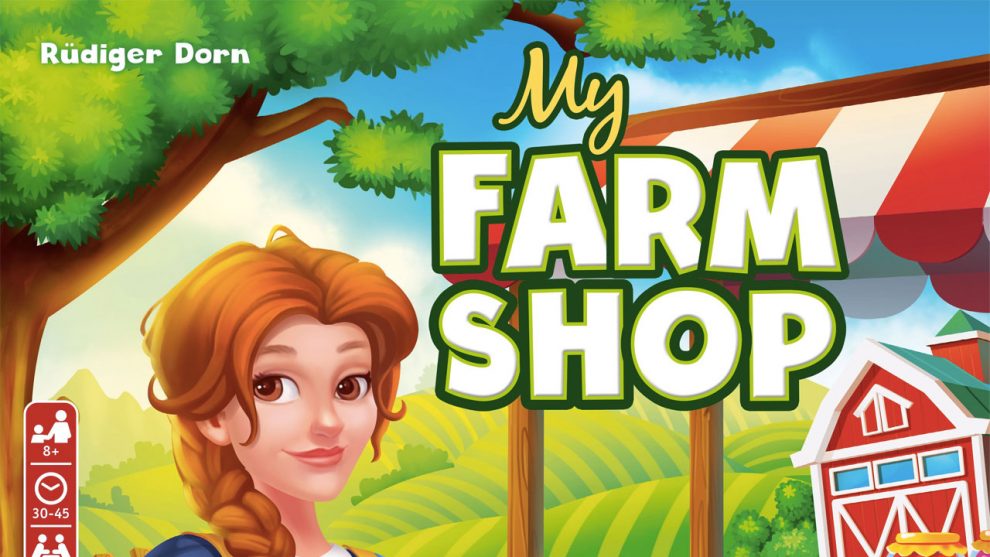

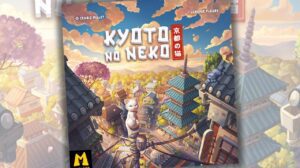

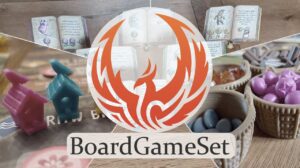





Add Comment